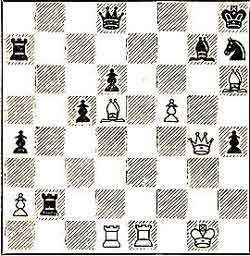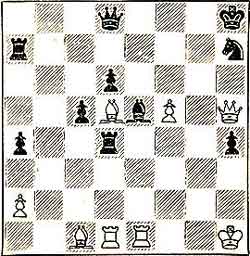The games of the U.S.A.- U.S.S.R Radio Match are re-
published with annotations b y the American players.
The second part of this series will appear next month.
3. MY
GAMES WITH BOLESLAVSKY
by Reuben Fine
CHESS REVIEW NOVEMBER 1945
|
34
P-B5
. .
. .
Almost wins. 34 Kt-Q5. KtxKt; 35 BxKt, QxP; 36 QxP,
Q-B3 is another line where Black escapes by a hair.
There was, however, an alternative which
might have worked out better than the variation I chose: 34 P-R4 (to
prevent ... P- Kt4 after P-B5). If then 34…QxP, not 35 P-B5, Kt~R2, but
simply 35 RxP! and Black will have to fight hard to defend himself. But
it would require a great deal of painstaking analysis to demonstrate a
forced win. Certainly, in time pressure, the text looked Just as good;
in fact, it does compel Black to defend perfectly for a long time, but
it so happens that there is always one move just good enough to hold
the game.
34 . . . .
Kt-R2
35
Q-Kt4
P-Kt4
36
Kt-Q5
Q-Q1
On 36 ... QxP; 37 P-R4 opens the Kt
file immediately.
37
P-R4
RxP
38
B-K3
. .
. .
To open the Kt file. On 38 R-Q3, RxP;
39 R-KKt3, B-K4! is sufficient.
38 . .
.
.
PxP
39
B-R6
BxKt
Forced.
40
BxBch
K-R1
Here the game was adjourned, Despite
exhaustive study, I was
unable to find any willing continuation.

41
B-B1
. .
. .
Everything else fails by a narrow
margin. On 41 Q-R5, Kt-B3; 42 BxBch. KxB; 43
QKt6ch; K-B1! (not –43 … K-Rl; 44
B-B7) is
sufficient. 41 Q-Kt6 is met by 41
... R-Kt1, threatening
... Q-B3. Most interesting is 41 R-K6, BxB; 42
R(Ql)-K-1! (not 42 RxB, R-Kt2; 43 R-Kt6, RxR; 44
PxR, Q-Kt4!), but here too, 42 ...R-Ktl; ,43 RxB, R-KKt2; 44
R-Kt6, QKt4!! is enough. And in all these variations, if Black gets to
the endgame unmolested, he is two Pawns ahead and should
win.
41 . .
. .
RKt5
Only. On 41…. R-QB7; 42 Q-K4 wins at once.
42
Q-R5
B-K4
43
K-R1
. . . .
The
tempting 43 B-R6 is met by 43 …Kt-B3!
43 . .
. .
RQ5
Boleslavsky defends superbly.

44
RxR
PxR
45
B-KB4
. . . .
Another crisis in a game of crises. The threat is
of course RxB.
45 . . .
.
P-Q6
Again best. If
instead 45, .. R-K2?; 46
B-Kt5, Q-Kl; 47 B-B6ch! decides, while if 45 ... R-KKt2; 46 B-R6,
R-Kt6; 47 R-QKt1, R-R6ch; 48 K-Kt2, R-Kt6ch; 49 K-B1, Q-QB1; 50
R-Kt7! B-Kt2!; 51 Q-B7,
Q-Bl
(extraordinary that Black has no checks); 52 BxBch, RxB; 53
QxQch, KtxQ; 54 R-Kt8 and wins a piece or the exchange, with a probable
endgame win.
46
P-B6
. . . .
Enforced liquidation. 46 RxB, PxR; 47
BxPch, R-Kt2; 48 Q-B7, Q-KB1 fails because of
Black's QP.
46…..
P-Q7
47
BxP
QxP
48
R-QB1
Q-B1
49
QxP
. . . .
To threaten Q-R3. But the defense has become
easy.
49 . .
. .
R-QB2!
50 R-KKt1 R-KKt2
51 RxR .
. .
.
Or 51.
R-Ktl, Q-BI.
Drawn. A fascinating game.
|
|

Isaac
Boleslavsky
Reuben Fine
In the first game, Boleslavsky defends a desperate
position with resourceful tenacity. The return encounter sees Fine
losing virtually in the opening stage. – Ed.
KING’S INDIAN
DEFENSE
R.Fine Boleslavsky
White
Black
1
P-Q4
Kt-KB3
2
P-QB4
P-Q3
The Old Indian, or Tchigorin Defense, which Boleslavsky is quite fond
of.
3
P-KKt3
. . . .
To transform to the
regular King's Indian. 3 Kt-QB3. P-K4; 4 PxP, PxP; 5 QxQ ch, tried in
some Soviet tournaments does not look good.
3
. . . .
P-KKt3
4
B-Kt2
B-Kt2
5
P-K4
. . . .
5 Kt-KB3, to hold….P-K4 off for a few moves, may be better.
5 . .
. .
O-O
6
Kt-K2
P-K4
7
O-O
. . . .

7 . .
. . PxP
This move took me by surprise. Black
cannot afford to give up the center In this variation unless he can
obtain adequate counterplay against the KP or the QBP. From now on the
struggle is between White's attempt to develop normally and
take advantage of his superior Pawn position, and
Black's efforts to maintain enough tactical threats
to spoil White’s plans.
8
KtxP
KtB3
First
disruption : White cannot play his QKt out to B3 because of
….KtxKP.
9
Kt-B2
. . . .
|
At this point I must confess
that an overdose of simultaneous exhibitions and an underdose
of serious tournament chess in the past few years combined to make me
overconfident. In such positions it is essential to balance White's
developmental possibilities against Black’s interruptions and only
serious practice against first class opposition can provide the
necessary judgment. 9 KtxKt looked very tempting but after 9 ... PxKt;
10 P-K5, PxP; 11 BxP, B-R6! Black seems to get out.
9 . .
. .
B-K3
10
Kt-K3
. . . .
Since White's QKt has to go to R3 anyhow later,
I could
just as well have played
10 QKt-R3 at once; the Kt is uncomfortable at K3.
10 . .
. .
Kt-K4
11
Kt-R3
. . . .
On 11 Q-B2, or 11 Q-K2, KKt-Kt5 again follows, with
serious threats all over.
11 . . . .
Kt(B3)-Kt5
12
Kt-Q5
. . . .
To avoid exchanges. On 12 KtxKt. KtxKt;
13 R-Kt1, P-KB4 Black’s initiative is very strong.
12 . . . .
P-QB3
13
Kt-B4
B-B1
The Pawn is immune because Black’s KKt is
loose.
14
B-Q2
. . . .
|
|
|
White maintains the better Pawn position but the
price is awkward development.
14 . . . .
P-KB4
15
Q-Kt3
PxP
16
BxP
Kt-B3
17
B-Kt2
. . . .
White still has most of the pressure; If
his Knights were better placed,
he would have a won game.
17. .
. .
Q-B2
18 QR-Q1 . . . .
To keep an eye on the QP; 18 QR-K1 was a good alternative.
18 . . . .
B-Kt5
19
P-B3
B-B4
20
B-Kt4
Kt-B2
Not
20…QR-Q1?; 21 BxP and P-B5 ch.

21
P-Kt4
. . . .
The capture of the QP now is not advantageous;
there would follow 21 BxP, KtxB; 22 RxKt, P-KKt4; 23 P-B55
ch, K-Rl; 24 Kt-K6, BxKt; 25 RxB (or 25 QxB, Q-R4). Kt-Q4 and Black's
pieces are all ideally placed-the extra Pawn is worthless.
21 . .
. .
B-Q2
A fantastically complicated position. All along
there are tantalizing alternatives, many of which seem to
win. but none have subsequently
been confirmed by exact analysis.
22
Kt-B2 . . . .
Aiming for K6. On 22 P-Kt5, Kt-Kl (threatening ...
KtxKtP) 23 P-R4 is met by 23 ... Q-Kt3ch. If
then
24 P-B5, PxP; 25RxB, PxBch; 26 K-Rl. PxKt and we must
conclude that the attack is not worth apiece.
22
. . . .
P-QR4
An energetic
counter-attack.
23
B-K1
P-R5
24
Q-Kt4
P-QKt4!
He is determined to obtain some
real counterplay against White's Q-side. It
was
impossible here to foresee whether the subsequent weakening of the
Pawns could be tolerated by Black or not; that Boleslavsky
chose the line anyhow is indicative of his style and temperament.
25
PxP
Q-Kt3ch
26
B-B2
P-B4
The point. Black regains the Pawn and can apply
pressure along the QKt file.
27
KR-K1
KR-Kt1
28 Q-Q2 BxQKtP
With
excellent judgment. On 28 ... QxP; 29 B-BI, QxP; 30 B-B4
is
extremely difficult to meet.
29
P-Kt5
. . . .
Obviously White's course must be a K·side attack.
29 . .
. .
KtxP
30
KtxP
. . . .
30 Kt-Q5 fails against 30
KtxKt; 31 QxKtch, Kt-B2; 32 R-K7, B-Kl, From here on the game is full
of such intriguing combinations which fail by one move.
30 . .
.
.
PxKt
31
QxKt
B-K1
32
P-B4
R-R2
The sacrifice of the exchange is not advisable. On 32 ... QxP there
would follow 33 BxR, RxB; 34 RxP!
33
Kt-K3
B-B2

|
|
|
RUY LOPEZ
I.
Boleslavsky
R.Fine
White
Black
1
P-K4
P-K4
2
Kt-KB3
Kt-QB3
3
B-Kt5
P-QR3
4 B-R4
B-Q3
5
P-B4
B-Q2
6
Kt-B3
P-KKt3
A
risky defense, which I adopted chiefly because of the score.
7
P-Q4
PxP
8
KtxP
B-Kt2
9
KtxKt
……
With a view to the subsequent advance of the BP. 9 B-K3 is a good
alternative.
9…..
PxKt?
After this Black gets much of the worse of it. 9….BxKt was essential,
with fair prospects.
10
O-O
Kt-K2

11
P-B5!
….
This seems to win by force, and refute Black’s
opening completely.
11
…..
Kt-B1
11 ... PxP; 12 B-K3 is no
better.
12
B-K3
O-O
13
Q-Q2
Q-K2
|
Desperately trying to get some
air.
14
QR-Q1
B-K1
15
P-B4
P-B4
To
allow P-B5 would have been suicidal.
16
KPxP
KtPxP
17
KR-K1
….. ..
Black has freed his game slightly, but the Kt and
QR are still badly misplaced.
17…..
PxP
18
Q-KB2
…...
Simplest and best.
18…….
Kt-Q3
19
QBxP
Q-Q1
20
B-Q4
….
Threatening B-K5.
20…..
BxB
21
QxB
Q-B3
The endgame offers some hope although it is
theoretically lost.
22
B-Kt3ch
…..
Not 22 QxQ, RxQ; 23 R-K7, R-B2; 24 B-Kt3, K-B1!
22 . .
.
.
K-R1
23
QxQch
RxQ
24
R-K7
R-QB1
The Pawn itself is of little
importance, but there is no good way to give it up.
25
R(1)-K1
B-Kt3
The best drawing chance is all ending
with R and
B vs. R and
B. On
25.,.B-B 2; 26 BxB, RxB; 27 RxR, KtxR; 28 R-K7, K-Kt2; 29
Kt-R4 maintains the Rook on the seventh, which is enough to
will.
26
R(1)-K6
RxR
Or
26 ... R(3)-Bl; 27 R-K5.
27
BxR
R-K1
If
27 ... R-QKtl; 23
P-Kt3 follows.
28
RxRch
BxR
29
Kt-R4
…….
|
Fixing the Q·side Pawns once and for all. Black,
has not managed to get
a drawable endgame, and with the bad Pawns on the Q-side the remainder
is relatively simple.
29
….
K-Kt2
30
Kt-B5 P-QR4
31
K-B2
B-B2
Hoping for ... Kt-K5ch: ,32 KtxKt, BxB.
32
BxB
KxB
33
P-QKt3
P-R4
34
P-Kt3
K-K2
35
K-K3
Kt_Kt4
36
Kt-Kt7
P-B4
A last gasp.
37
KtxRP
K-Q3
38 Kt-B4ch K-Q4
39
K-Q3
Kt-Q3
40
KtxKt
……..
Surprising but accurate.
40
..…
PxKt

41
P-QR3
….
The sealed move, which was radioed
"open for my inspection." Against a careless continuation such as 41
K-K3, K-B3; 42 K-B3, P-Q4 Black may very well draw, but after the text
the Q·side Pawns will be liquidated and White will win on the
K-side.
41
. . .
.
Resigns.
I have lost such games only to the very
greatest masters.
|







